Scenario Based Essay: Leadership Style's Influence on Patient Safety
VerifiedAdded on 2021/02/21
|9
|2374
|57
Essay
AI Summary
This essay delves into the crucial relationship between leadership styles and patient safety within healthcare settings. It begins by defining leadership and patient safety, emphasizing the importance of effective clinical leadership in guiding healthcare professionals. The main body of the essay examines how different leadership styles, such as situational and autocratic approaches, impact patient outcomes. It highlights the benefits and drawbacks of each style, using examples to illustrate their effects on medication safety, error reporting, and overall quality of care. The essay also discusses the importance of adapting leadership styles to specific situations, such as during crises or when dealing with inexperienced staff. Ultimately, the essay concludes that effective leadership is essential for fostering a culture of safety, improving patient outcomes, and ensuring high-quality healthcare services.

Critical Reflection
Scenario Based Essay
Scenario Based Essay
Paraphrase This Document
Need a fresh take? Get an instant paraphrase of this document with our AI Paraphraser
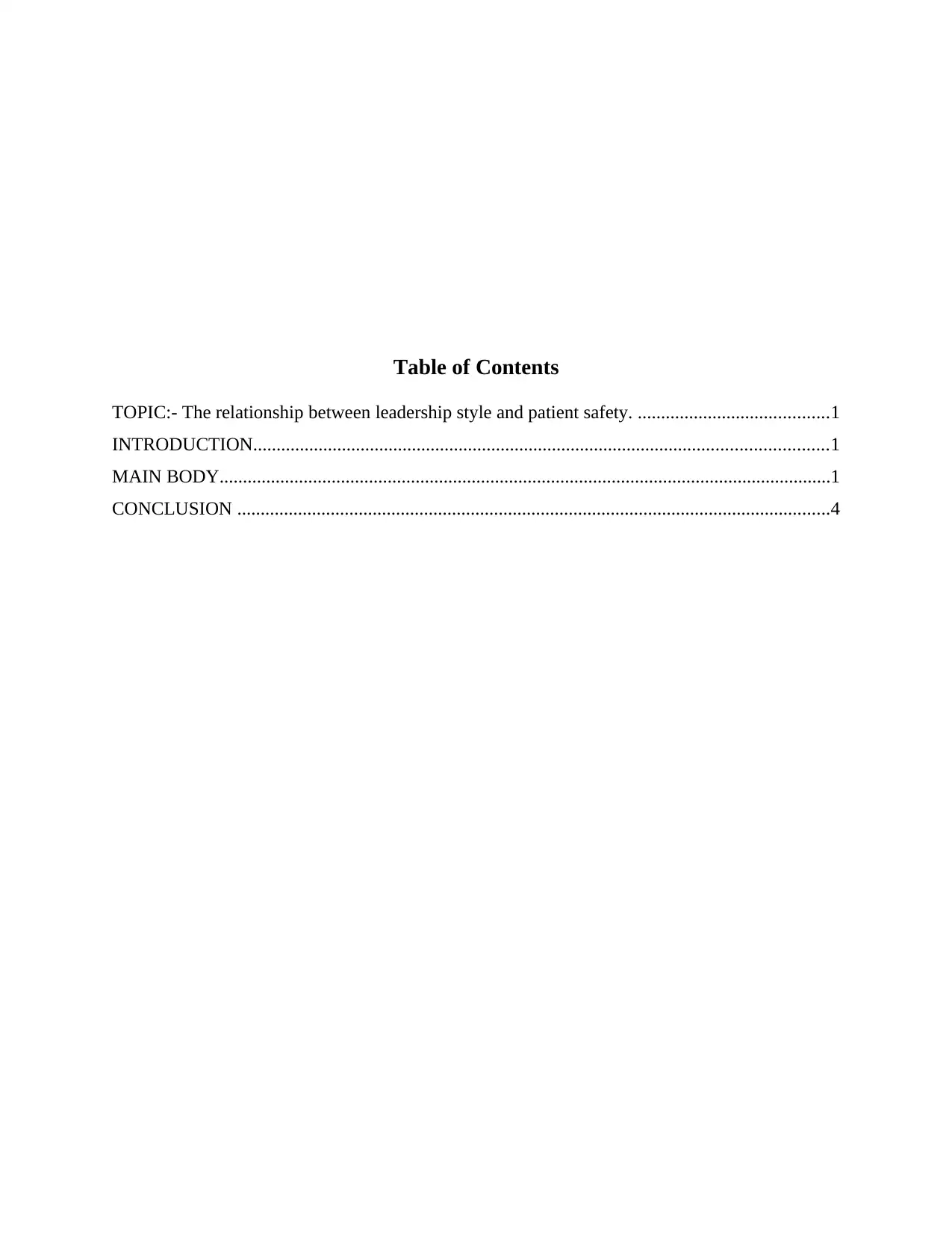
Table of Contents
TOPIC:- The relationship between leadership style and patient safety. .........................................1
INTRODUCTION...........................................................................................................................1
MAIN BODY...................................................................................................................................1
CONCLUSION ...............................................................................................................................4
TOPIC:- The relationship between leadership style and patient safety. .........................................1
INTRODUCTION...........................................................................................................................1
MAIN BODY...................................................................................................................................1
CONCLUSION ...............................................................................................................................4
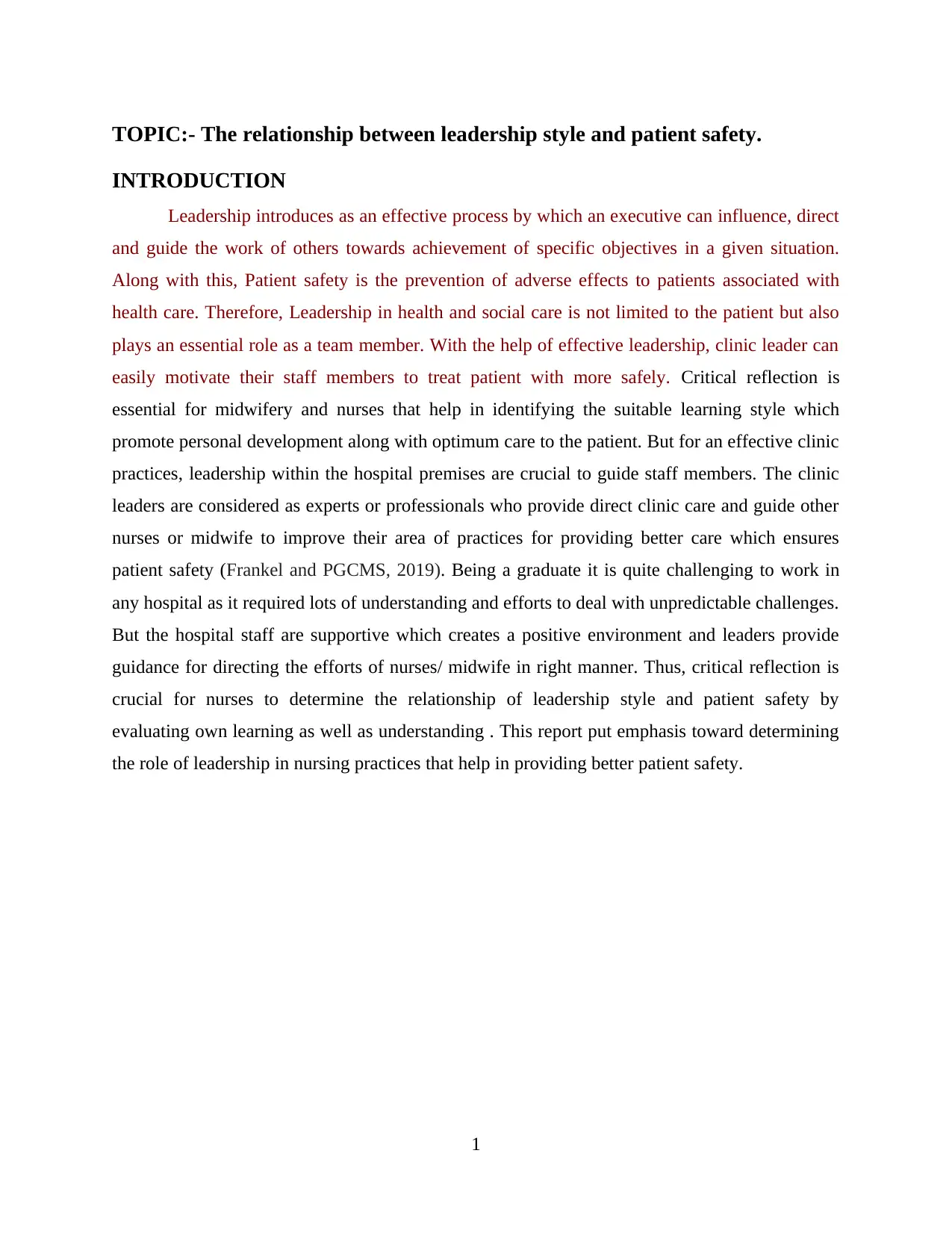
TOPIC:- The relationship between leadership style and patient safety.
INTRODUCTION
Leadership introduces as an effective process by which an executive can influence, direct
and guide the work of others towards achievement of specific objectives in a given situation.
Along with this, Patient safety is the prevention of adverse effects to patients associated with
health care. Therefore, Leadership in health and social care is not limited to the patient but also
plays an essential role as a team member. With the help of effective leadership, clinic leader can
easily motivate their staff members to treat patient with more safely. Critical reflection is
essential for midwifery and nurses that help in identifying the suitable learning style which
promote personal development along with optimum care to the patient. But for an effective clinic
practices, leadership within the hospital premises are crucial to guide staff members. The clinic
leaders are considered as experts or professionals who provide direct clinic care and guide other
nurses or midwife to improve their area of practices for providing better care which ensures
patient safety (Frankel and PGCMS, 2019). Being a graduate it is quite challenging to work in
any hospital as it required lots of understanding and efforts to deal with unpredictable challenges.
But the hospital staff are supportive which creates a positive environment and leaders provide
guidance for directing the efforts of nurses/ midwife in right manner. Thus, critical reflection is
crucial for nurses to determine the relationship of leadership style and patient safety by
evaluating own learning as well as understanding . This report put emphasis toward determining
the role of leadership in nursing practices that help in providing better patient safety.
1
INTRODUCTION
Leadership introduces as an effective process by which an executive can influence, direct
and guide the work of others towards achievement of specific objectives in a given situation.
Along with this, Patient safety is the prevention of adverse effects to patients associated with
health care. Therefore, Leadership in health and social care is not limited to the patient but also
plays an essential role as a team member. With the help of effective leadership, clinic leader can
easily motivate their staff members to treat patient with more safely. Critical reflection is
essential for midwifery and nurses that help in identifying the suitable learning style which
promote personal development along with optimum care to the patient. But for an effective clinic
practices, leadership within the hospital premises are crucial to guide staff members. The clinic
leaders are considered as experts or professionals who provide direct clinic care and guide other
nurses or midwife to improve their area of practices for providing better care which ensures
patient safety (Frankel and PGCMS, 2019). Being a graduate it is quite challenging to work in
any hospital as it required lots of understanding and efforts to deal with unpredictable challenges.
But the hospital staff are supportive which creates a positive environment and leaders provide
guidance for directing the efforts of nurses/ midwife in right manner. Thus, critical reflection is
crucial for nurses to determine the relationship of leadership style and patient safety by
evaluating own learning as well as understanding . This report put emphasis toward determining
the role of leadership in nursing practices that help in providing better patient safety.
1
⊘ This is a preview!⊘
Do you want full access?
Subscribe today to unlock all pages.

Trusted by 1+ million students worldwide
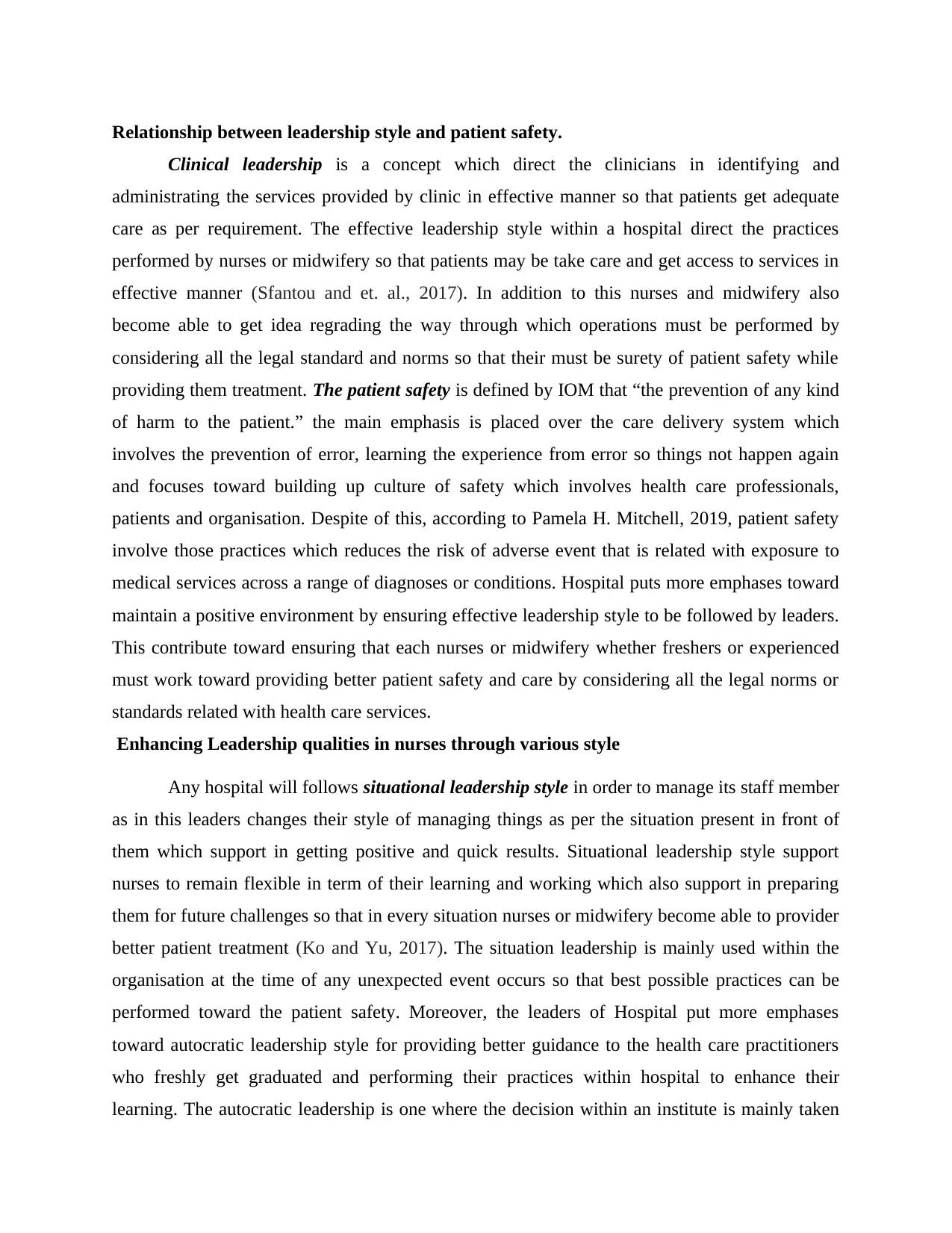
Relationship between leadership style and patient safety.
Clinical leadership is a concept which direct the clinicians in identifying and
administrating the services provided by clinic in effective manner so that patients get adequate
care as per requirement. The effective leadership style within a hospital direct the practices
performed by nurses or midwifery so that patients may be take care and get access to services in
effective manner (Sfantou and et. al., 2017). In addition to this nurses and midwifery also
become able to get idea regrading the way through which operations must be performed by
considering all the legal standard and norms so that their must be surety of patient safety while
providing them treatment. The patient safety is defined by IOM that “the prevention of any kind
of harm to the patient.” the main emphasis is placed over the care delivery system which
involves the prevention of error, learning the experience from error so things not happen again
and focuses toward building up culture of safety which involves health care professionals,
patients and organisation. Despite of this, according to Pamela H. Mitchell, 2019, patient safety
involve those practices which reduces the risk of adverse event that is related with exposure to
medical services across a range of diagnoses or conditions. Hospital puts more emphases toward
maintain a positive environment by ensuring effective leadership style to be followed by leaders.
This contribute toward ensuring that each nurses or midwifery whether freshers or experienced
must work toward providing better patient safety and care by considering all the legal norms or
standards related with health care services.
Enhancing Leadership qualities in nurses through various style
Any hospital will follows situational leadership style in order to manage its staff member
as in this leaders changes their style of managing things as per the situation present in front of
them which support in getting positive and quick results. Situational leadership style support
nurses to remain flexible in term of their learning and working which also support in preparing
them for future challenges so that in every situation nurses or midwifery become able to provider
better patient treatment (Ko and Yu, 2017). The situation leadership is mainly used within the
organisation at the time of any unexpected event occurs so that best possible practices can be
performed toward the patient safety. Moreover, the leaders of Hospital put more emphases
toward autocratic leadership style for providing better guidance to the health care practitioners
who freshly get graduated and performing their practices within hospital to enhance their
learning. The autocratic leadership is one where the decision within an institute is mainly taken
Clinical leadership is a concept which direct the clinicians in identifying and
administrating the services provided by clinic in effective manner so that patients get adequate
care as per requirement. The effective leadership style within a hospital direct the practices
performed by nurses or midwifery so that patients may be take care and get access to services in
effective manner (Sfantou and et. al., 2017). In addition to this nurses and midwifery also
become able to get idea regrading the way through which operations must be performed by
considering all the legal standard and norms so that their must be surety of patient safety while
providing them treatment. The patient safety is defined by IOM that “the prevention of any kind
of harm to the patient.” the main emphasis is placed over the care delivery system which
involves the prevention of error, learning the experience from error so things not happen again
and focuses toward building up culture of safety which involves health care professionals,
patients and organisation. Despite of this, according to Pamela H. Mitchell, 2019, patient safety
involve those practices which reduces the risk of adverse event that is related with exposure to
medical services across a range of diagnoses or conditions. Hospital puts more emphases toward
maintain a positive environment by ensuring effective leadership style to be followed by leaders.
This contribute toward ensuring that each nurses or midwifery whether freshers or experienced
must work toward providing better patient safety and care by considering all the legal norms or
standards related with health care services.
Enhancing Leadership qualities in nurses through various style
Any hospital will follows situational leadership style in order to manage its staff member
as in this leaders changes their style of managing things as per the situation present in front of
them which support in getting positive and quick results. Situational leadership style support
nurses to remain flexible in term of their learning and working which also support in preparing
them for future challenges so that in every situation nurses or midwifery become able to provider
better patient treatment (Ko and Yu, 2017). The situation leadership is mainly used within the
organisation at the time of any unexpected event occurs so that best possible practices can be
performed toward the patient safety. Moreover, the leaders of Hospital put more emphases
toward autocratic leadership style for providing better guidance to the health care practitioners
who freshly get graduated and performing their practices within hospital to enhance their
learning. The autocratic leadership is one where the decision within an institute is mainly taken
Paraphrase This Document
Need a fresh take? Get an instant paraphrase of this document with our AI Paraphraser
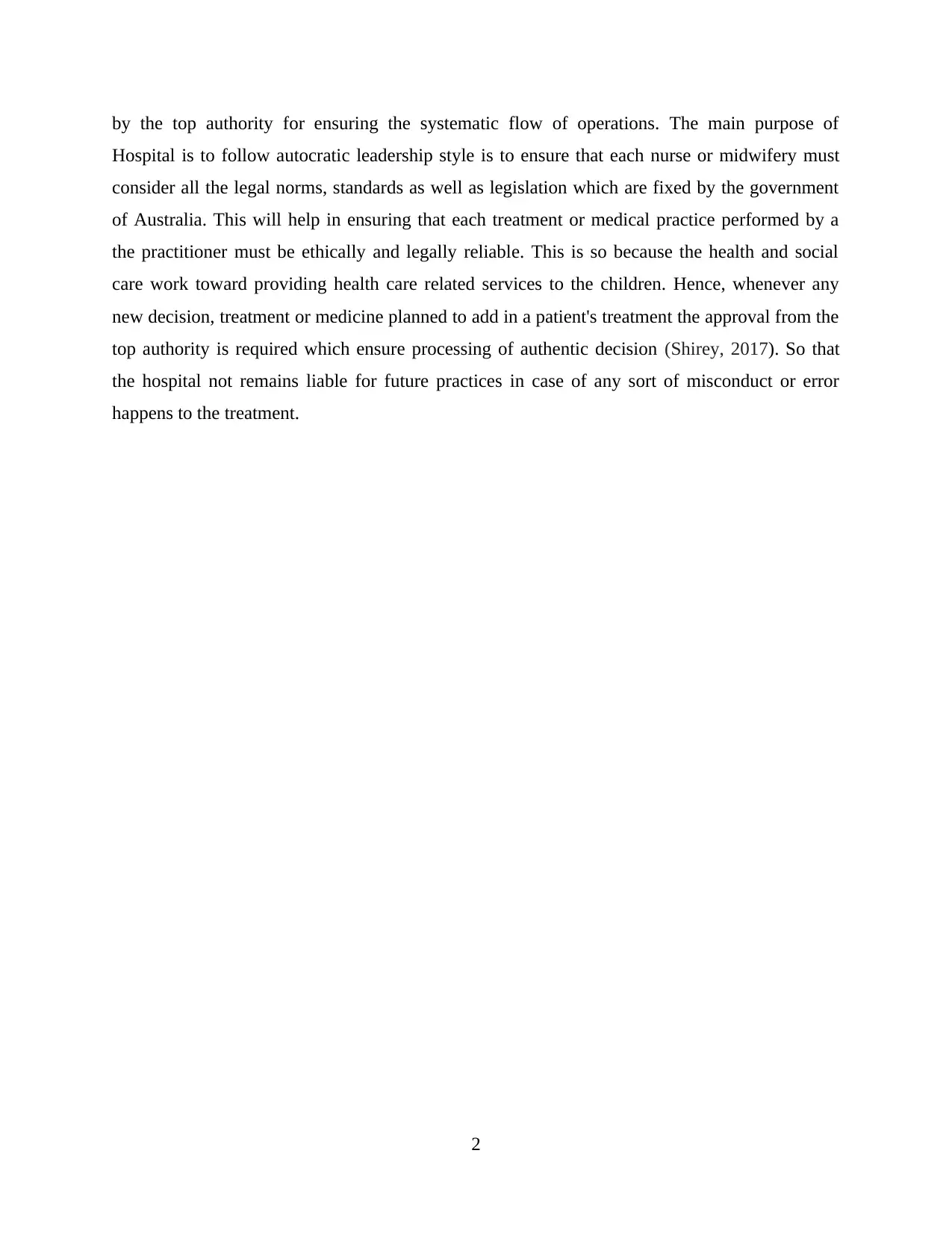
by the top authority for ensuring the systematic flow of operations. The main purpose of
Hospital is to follow autocratic leadership style is to ensure that each nurse or midwifery must
consider all the legal norms, standards as well as legislation which are fixed by the government
of Australia. This will help in ensuring that each treatment or medical practice performed by a
the practitioner must be ethically and legally reliable. This is so because the health and social
care work toward providing health care related services to the children. Hence, whenever any
new decision, treatment or medicine planned to add in a patient's treatment the approval from the
top authority is required which ensure processing of authentic decision (Shirey, 2017). So that
the hospital not remains liable for future practices in case of any sort of misconduct or error
happens to the treatment.
2
Hospital is to follow autocratic leadership style is to ensure that each nurse or midwifery must
consider all the legal norms, standards as well as legislation which are fixed by the government
of Australia. This will help in ensuring that each treatment or medical practice performed by a
the practitioner must be ethically and legally reliable. This is so because the health and social
care work toward providing health care related services to the children. Hence, whenever any
new decision, treatment or medicine planned to add in a patient's treatment the approval from the
top authority is required which ensure processing of authentic decision (Shirey, 2017). So that
the hospital not remains liable for future practices in case of any sort of misconduct or error
happens to the treatment.
2
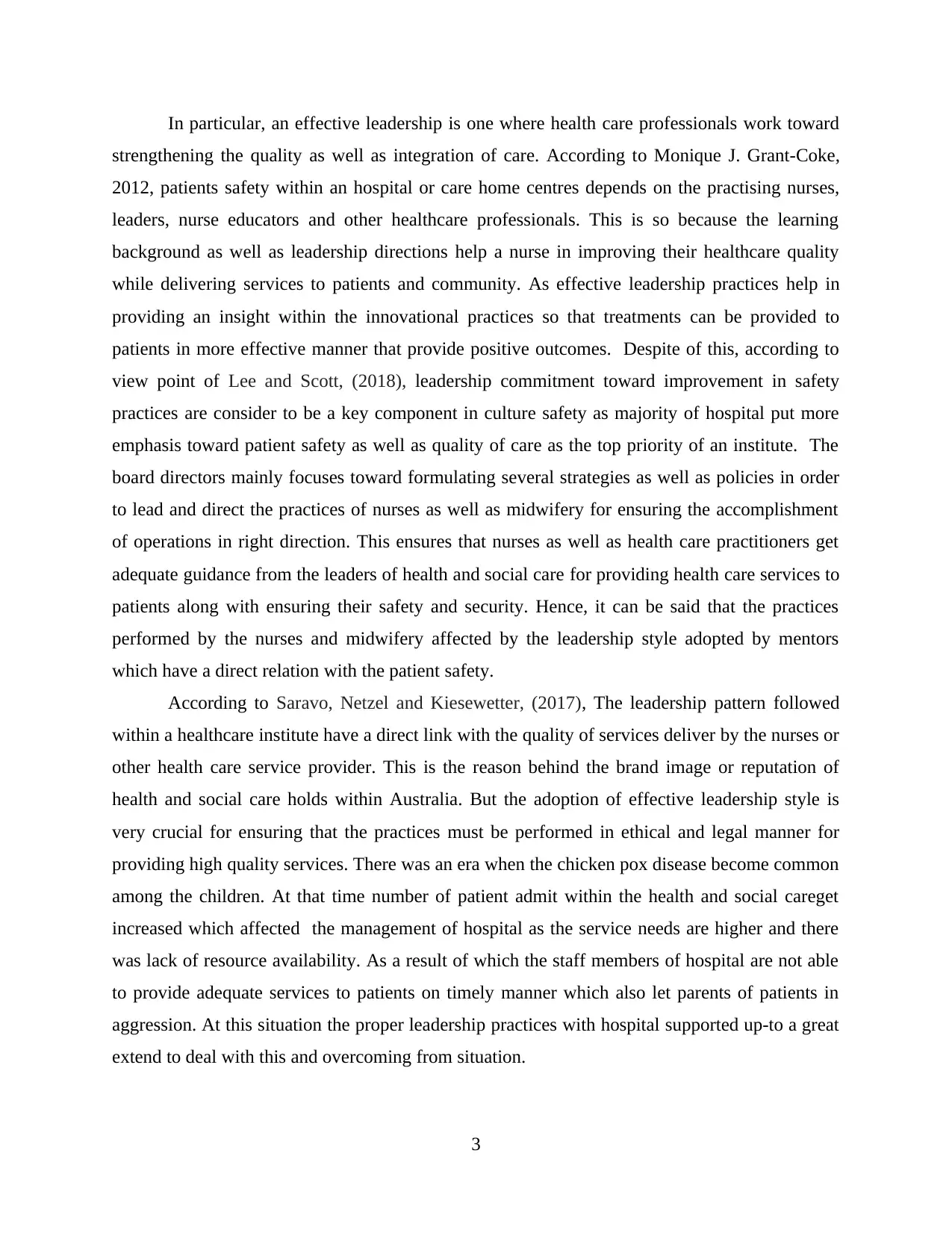
In particular, an effective leadership is one where health care professionals work toward
strengthening the quality as well as integration of care. According to Monique J. Grant-Coke,
2012, patients safety within an hospital or care home centres depends on the practising nurses,
leaders, nurse educators and other healthcare professionals. This is so because the learning
background as well as leadership directions help a nurse in improving their healthcare quality
while delivering services to patients and community. As effective leadership practices help in
providing an insight within the innovational practices so that treatments can be provided to
patients in more effective manner that provide positive outcomes. Despite of this, according to
view point of Lee and Scott, (2018), leadership commitment toward improvement in safety
practices are consider to be a key component in culture safety as majority of hospital put more
emphasis toward patient safety as well as quality of care as the top priority of an institute. The
board directors mainly focuses toward formulating several strategies as well as policies in order
to lead and direct the practices of nurses as well as midwifery for ensuring the accomplishment
of operations in right direction. This ensures that nurses as well as health care practitioners get
adequate guidance from the leaders of health and social care for providing health care services to
patients along with ensuring their safety and security. Hence, it can be said that the practices
performed by the nurses and midwifery affected by the leadership style adopted by mentors
which have a direct relation with the patient safety.
According to Saravo, Netzel and Kiesewetter, (2017), The leadership pattern followed
within a healthcare institute have a direct link with the quality of services deliver by the nurses or
other health care service provider. This is the reason behind the brand image or reputation of
health and social care holds within Australia. But the adoption of effective leadership style is
very crucial for ensuring that the practices must be performed in ethical and legal manner for
providing high quality services. There was an era when the chicken pox disease become common
among the children. At that time number of patient admit within the health and social careget
increased which affected the management of hospital as the service needs are higher and there
was lack of resource availability. As a result of which the staff members of hospital are not able
to provide adequate services to patients on timely manner which also let parents of patients in
aggression. At this situation the proper leadership practices with hospital supported up-to a great
extend to deal with this and overcoming from situation.
3
strengthening the quality as well as integration of care. According to Monique J. Grant-Coke,
2012, patients safety within an hospital or care home centres depends on the practising nurses,
leaders, nurse educators and other healthcare professionals. This is so because the learning
background as well as leadership directions help a nurse in improving their healthcare quality
while delivering services to patients and community. As effective leadership practices help in
providing an insight within the innovational practices so that treatments can be provided to
patients in more effective manner that provide positive outcomes. Despite of this, according to
view point of Lee and Scott, (2018), leadership commitment toward improvement in safety
practices are consider to be a key component in culture safety as majority of hospital put more
emphasis toward patient safety as well as quality of care as the top priority of an institute. The
board directors mainly focuses toward formulating several strategies as well as policies in order
to lead and direct the practices of nurses as well as midwifery for ensuring the accomplishment
of operations in right direction. This ensures that nurses as well as health care practitioners get
adequate guidance from the leaders of health and social care for providing health care services to
patients along with ensuring their safety and security. Hence, it can be said that the practices
performed by the nurses and midwifery affected by the leadership style adopted by mentors
which have a direct relation with the patient safety.
According to Saravo, Netzel and Kiesewetter, (2017), The leadership pattern followed
within a healthcare institute have a direct link with the quality of services deliver by the nurses or
other health care service provider. This is the reason behind the brand image or reputation of
health and social care holds within Australia. But the adoption of effective leadership style is
very crucial for ensuring that the practices must be performed in ethical and legal manner for
providing high quality services. There was an era when the chicken pox disease become common
among the children. At that time number of patient admit within the health and social careget
increased which affected the management of hospital as the service needs are higher and there
was lack of resource availability. As a result of which the staff members of hospital are not able
to provide adequate services to patients on timely manner which also let parents of patients in
aggression. At this situation the proper leadership practices with hospital supported up-to a great
extend to deal with this and overcoming from situation.
3
⊘ This is a preview!⊘
Do you want full access?
Subscribe today to unlock all pages.

Trusted by 1+ million students worldwide
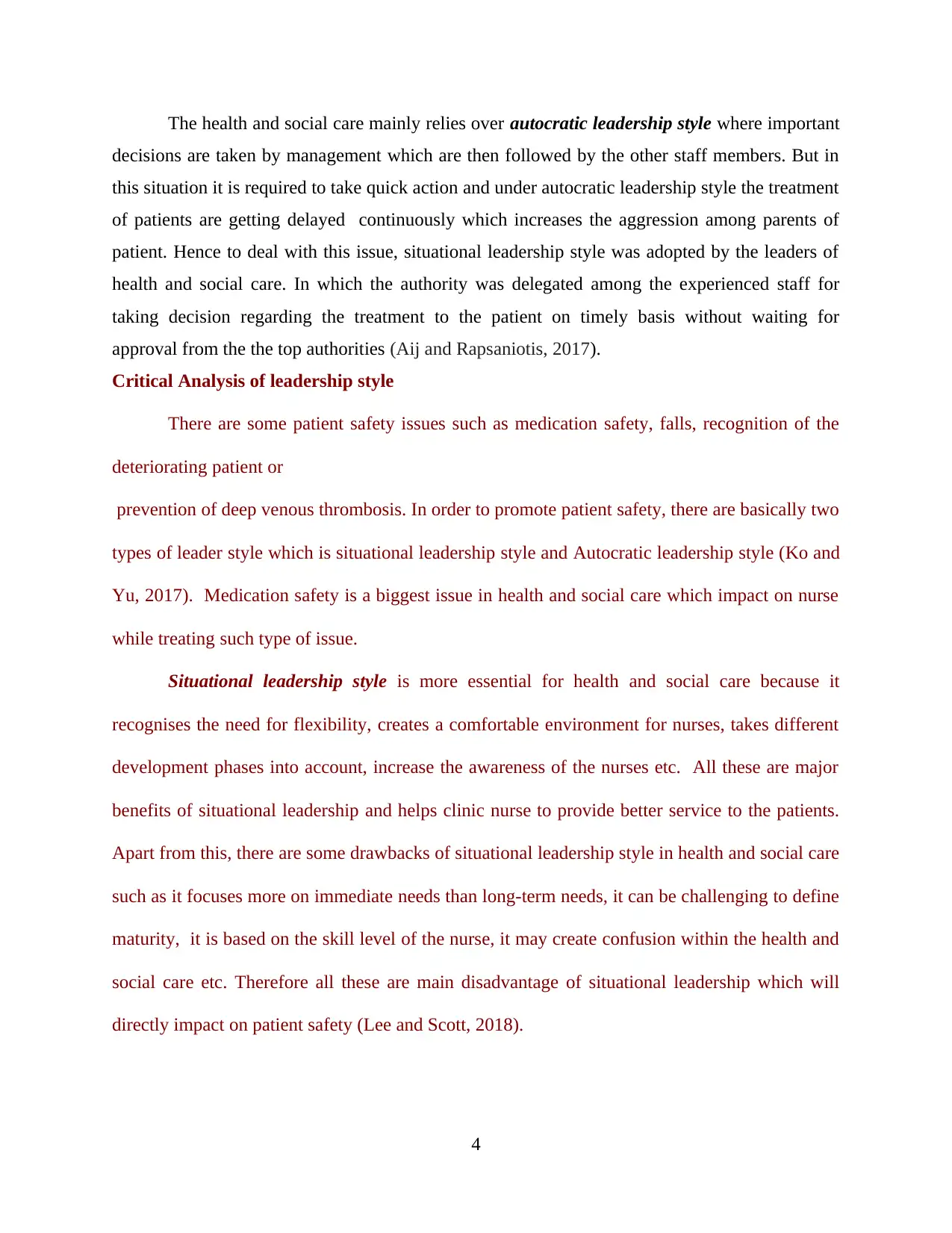
The health and social care mainly relies over autocratic leadership style where important
decisions are taken by management which are then followed by the other staff members. But in
this situation it is required to take quick action and under autocratic leadership style the treatment
of patients are getting delayed continuously which increases the aggression among parents of
patient. Hence to deal with this issue, situational leadership style was adopted by the leaders of
health and social care. In which the authority was delegated among the experienced staff for
taking decision regarding the treatment to the patient on timely basis without waiting for
approval from the the top authorities (Aij and Rapsaniotis, 2017).
Critical Analysis of leadership style
There are some patient safety issues such as medication safety, falls, recognition of the
deteriorating patient or
prevention of deep venous thrombosis. In order to promote patient safety, there are basically two
types of leader style which is situational leadership style and Autocratic leadership style (Ko and
Yu, 2017). Medication safety is a biggest issue in health and social care which impact on nurse
while treating such type of issue.
Situational leadership style is more essential for health and social care because it
recognises the need for flexibility, creates a comfortable environment for nurses, takes different
development phases into account, increase the awareness of the nurses etc. All these are major
benefits of situational leadership and helps clinic nurse to provide better service to the patients.
Apart from this, there are some drawbacks of situational leadership style in health and social care
such as it focuses more on immediate needs than long-term needs, it can be challenging to define
maturity, it is based on the skill level of the nurse, it may create confusion within the health and
social care etc. Therefore all these are main disadvantage of situational leadership which will
directly impact on patient safety (Lee and Scott, 2018).
4
decisions are taken by management which are then followed by the other staff members. But in
this situation it is required to take quick action and under autocratic leadership style the treatment
of patients are getting delayed continuously which increases the aggression among parents of
patient. Hence to deal with this issue, situational leadership style was adopted by the leaders of
health and social care. In which the authority was delegated among the experienced staff for
taking decision regarding the treatment to the patient on timely basis without waiting for
approval from the the top authorities (Aij and Rapsaniotis, 2017).
Critical Analysis of leadership style
There are some patient safety issues such as medication safety, falls, recognition of the
deteriorating patient or
prevention of deep venous thrombosis. In order to promote patient safety, there are basically two
types of leader style which is situational leadership style and Autocratic leadership style (Ko and
Yu, 2017). Medication safety is a biggest issue in health and social care which impact on nurse
while treating such type of issue.
Situational leadership style is more essential for health and social care because it
recognises the need for flexibility, creates a comfortable environment for nurses, takes different
development phases into account, increase the awareness of the nurses etc. All these are major
benefits of situational leadership and helps clinic nurse to provide better service to the patients.
Apart from this, there are some drawbacks of situational leadership style in health and social care
such as it focuses more on immediate needs than long-term needs, it can be challenging to define
maturity, it is based on the skill level of the nurse, it may create confusion within the health and
social care etc. Therefore all these are main disadvantage of situational leadership which will
directly impact on patient safety (Lee and Scott, 2018).
4
Paraphrase This Document
Need a fresh take? Get an instant paraphrase of this document with our AI Paraphraser
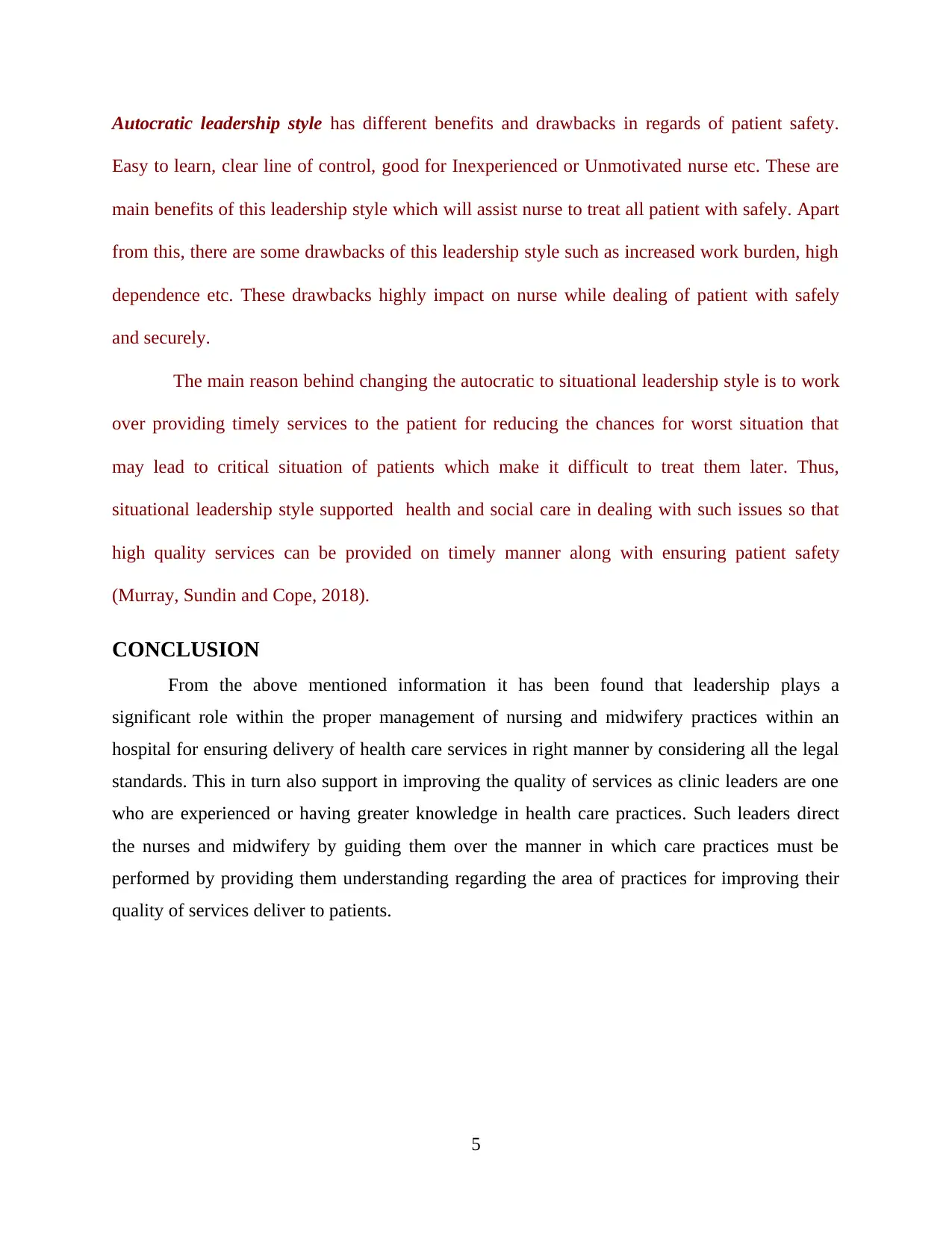
Autocratic leadership style has different benefits and drawbacks in regards of patient safety.
Easy to learn, clear line of control, good for Inexperienced or Unmotivated nurse etc. These are
main benefits of this leadership style which will assist nurse to treat all patient with safely. Apart
from this, there are some drawbacks of this leadership style such as increased work burden, high
dependence etc. These drawbacks highly impact on nurse while dealing of patient with safely
and securely.
The main reason behind changing the autocratic to situational leadership style is to work
over providing timely services to the patient for reducing the chances for worst situation that
may lead to critical situation of patients which make it difficult to treat them later. Thus,
situational leadership style supported health and social care in dealing with such issues so that
high quality services can be provided on timely manner along with ensuring patient safety
(Murray, Sundin and Cope, 2018).
CONCLUSION
From the above mentioned information it has been found that leadership plays a
significant role within the proper management of nursing and midwifery practices within an
hospital for ensuring delivery of health care services in right manner by considering all the legal
standards. This in turn also support in improving the quality of services as clinic leaders are one
who are experienced or having greater knowledge in health care practices. Such leaders direct
the nurses and midwifery by guiding them over the manner in which care practices must be
performed by providing them understanding regarding the area of practices for improving their
quality of services deliver to patients.
5
Easy to learn, clear line of control, good for Inexperienced or Unmotivated nurse etc. These are
main benefits of this leadership style which will assist nurse to treat all patient with safely. Apart
from this, there are some drawbacks of this leadership style such as increased work burden, high
dependence etc. These drawbacks highly impact on nurse while dealing of patient with safely
and securely.
The main reason behind changing the autocratic to situational leadership style is to work
over providing timely services to the patient for reducing the chances for worst situation that
may lead to critical situation of patients which make it difficult to treat them later. Thus,
situational leadership style supported health and social care in dealing with such issues so that
high quality services can be provided on timely manner along with ensuring patient safety
(Murray, Sundin and Cope, 2018).
CONCLUSION
From the above mentioned information it has been found that leadership plays a
significant role within the proper management of nursing and midwifery practices within an
hospital for ensuring delivery of health care services in right manner by considering all the legal
standards. This in turn also support in improving the quality of services as clinic leaders are one
who are experienced or having greater knowledge in health care practices. Such leaders direct
the nurses and midwifery by guiding them over the manner in which care practices must be
performed by providing them understanding regarding the area of practices for improving their
quality of services deliver to patients.
5
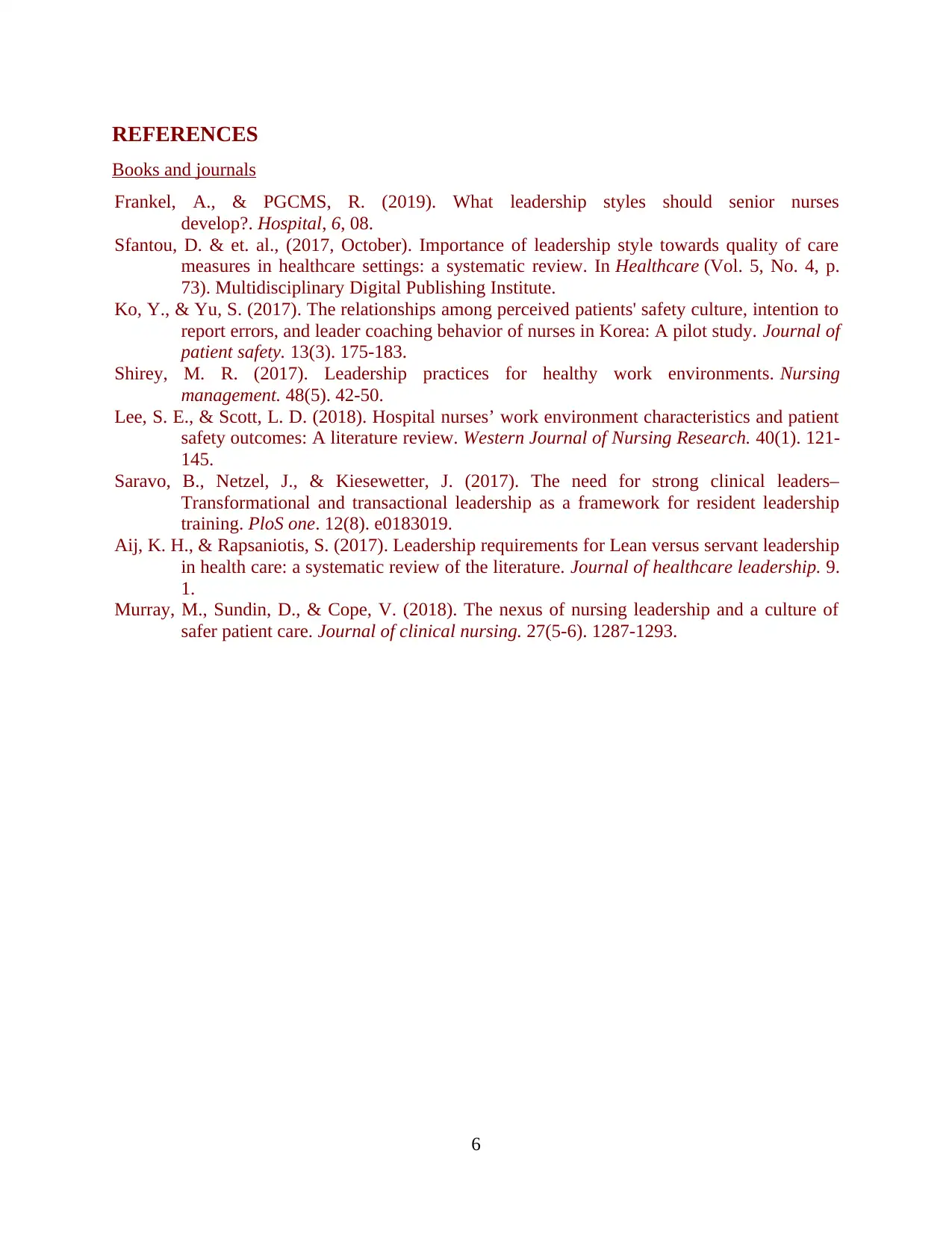
REFERENCES
Books and journals
Frankel, A., & PGCMS, R. (2019). What leadership styles should senior nurses
develop?. Hospital, 6, 08.
Sfantou, D. & et. al., (2017, October). Importance of leadership style towards quality of care
measures in healthcare settings: a systematic review. In Healthcare (Vol. 5, No. 4, p.
73). Multidisciplinary Digital Publishing Institute.
Ko, Y., & Yu, S. (2017). The relationships among perceived patients' safety culture, intention to
report errors, and leader coaching behavior of nurses in Korea: A pilot study. Journal of
patient safety. 13(3). 175-183.
Shirey, M. R. (2017). Leadership practices for healthy work environments. Nursing
management. 48(5). 42-50.
Lee, S. E., & Scott, L. D. (2018). Hospital nurses’ work environment characteristics and patient
safety outcomes: A literature review. Western Journal of Nursing Research. 40(1). 121-
145.
Saravo, B., Netzel, J., & Kiesewetter, J. (2017). The need for strong clinical leaders–
Transformational and transactional leadership as a framework for resident leadership
training. PloS one. 12(8). e0183019.
Aij, K. H., & Rapsaniotis, S. (2017). Leadership requirements for Lean versus servant leadership
in health care: a systematic review of the literature. Journal of healthcare leadership. 9.
1.
Murray, M., Sundin, D., & Cope, V. (2018). The nexus of nursing leadership and a culture of
safer patient care. Journal of clinical nursing. 27(5-6). 1287-1293.
6
Books and journals
Frankel, A., & PGCMS, R. (2019). What leadership styles should senior nurses
develop?. Hospital, 6, 08.
Sfantou, D. & et. al., (2017, October). Importance of leadership style towards quality of care
measures in healthcare settings: a systematic review. In Healthcare (Vol. 5, No. 4, p.
73). Multidisciplinary Digital Publishing Institute.
Ko, Y., & Yu, S. (2017). The relationships among perceived patients' safety culture, intention to
report errors, and leader coaching behavior of nurses in Korea: A pilot study. Journal of
patient safety. 13(3). 175-183.
Shirey, M. R. (2017). Leadership practices for healthy work environments. Nursing
management. 48(5). 42-50.
Lee, S. E., & Scott, L. D. (2018). Hospital nurses’ work environment characteristics and patient
safety outcomes: A literature review. Western Journal of Nursing Research. 40(1). 121-
145.
Saravo, B., Netzel, J., & Kiesewetter, J. (2017). The need for strong clinical leaders–
Transformational and transactional leadership as a framework for resident leadership
training. PloS one. 12(8). e0183019.
Aij, K. H., & Rapsaniotis, S. (2017). Leadership requirements for Lean versus servant leadership
in health care: a systematic review of the literature. Journal of healthcare leadership. 9.
1.
Murray, M., Sundin, D., & Cope, V. (2018). The nexus of nursing leadership and a culture of
safer patient care. Journal of clinical nursing. 27(5-6). 1287-1293.
6
⊘ This is a preview!⊘
Do you want full access?
Subscribe today to unlock all pages.

Trusted by 1+ million students worldwide
1 out of 9
Related Documents
Your All-in-One AI-Powered Toolkit for Academic Success.
+13062052269
info@desklib.com
Available 24*7 on WhatsApp / Email
![[object Object]](/_next/static/media/star-bottom.7253800d.svg)
Unlock your academic potential
Copyright © 2020–2025 A2Z Services. All Rights Reserved. Developed and managed by ZUCOL.





